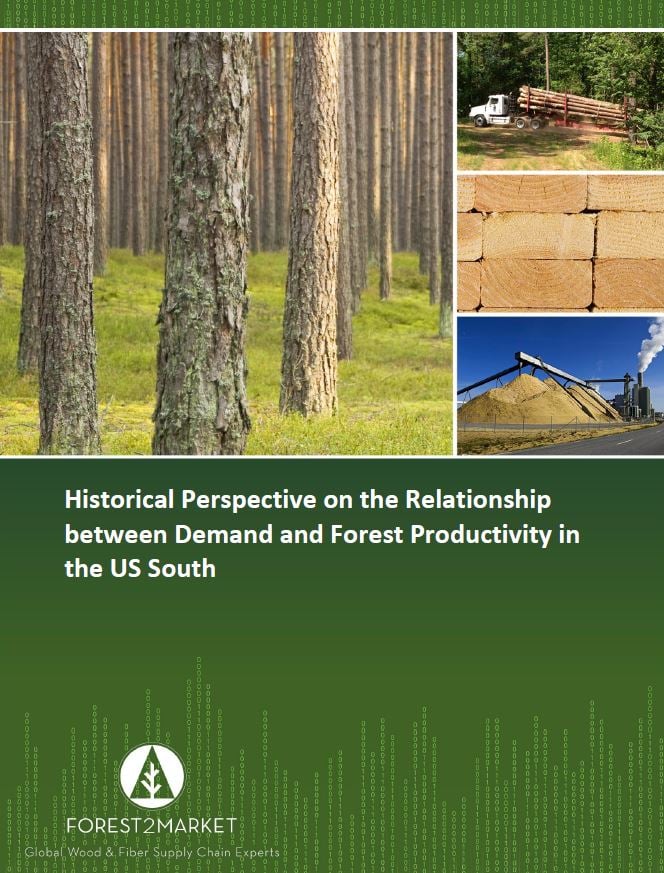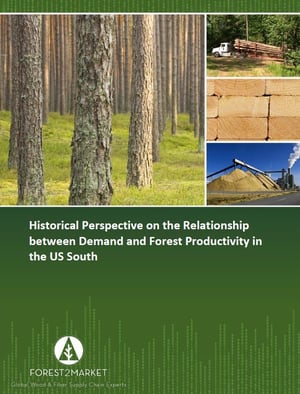3 min read
The Relationship between Demand and Forest Productivity in the US South: Part III
Hannah Jefferies : August 3, 2017

This is the third in a series of posts covering the recently-published report compiled by Forest2Market titled “Historical Perspective on the Relationship between Demand and Forest Productivity in the US South.” Our analysis uncovered seven key findings related to the relationship between demand and forest productivity, which will be explored in this series. This independent report was commissioned by Drax Group, plc, the National Alliance of Forest Owners and the US Endowment for Forestry & Communities, Inc.
Other posts in this series: Part 1 Part 2
Since the middle of the twentieth century, the amount of timberland—unreserved, productive forest land—in the US South has remained stable, increasing by about 3 percent between 1953 and 2015. During this period, economic growth and increased construction spurred consumer demand for forest products, which led timber harvests—or removals—to increase 57 percent. Yet over this same period, the amount of wood fiber—or inventory—stored in Southern forests increased 108 percent.
Forest2Market’s in-depth analysis of historical data over the past six decades documents the link between increased demand and increased inventory. Further, it explains that the dramatic increase in forest inventory was made possible by even more remarkable increases in productivity, especially on privately-owned timberlands. Encouraged by strong demand from the forest products industry, landowners made the long-term investments that were necessary to significantly improve forest productivity and increase inventory on a stable land base.
Key Finding #4
- Landowners responded to greater demand by investing in the future growth of their forests. The forest products industry played a critical role in promoting increases in forest productivity by funding public-private research projects to improve tree genetics and update silvicultural practices, which increased growth and yield, especially on plantation stands. Consistent and increasing demand for forest products assured other private landowners that engaging in more active (and expensive) management practices would provide financial dividends, which ensured more widespread adoption of improved management practices.
The rapid increases in Southern inventory since the 1950s coincided with consistent increases in forest products demand and removals through the mid-2000s. This increase in inventory alongside increasing removals on a relatively stable base of timberland acres could not have occurred without larger increases in growth. Private landowners have held an average of 90 percent of Southern timberland since 1953. Private owners’ actions, therefore, are largely responsible for changes in forest productivity.
In order to ensure that their mills would have a stable, high-quality source of supply, forest products companies invested heavily in research to promote forest productivity. This research, which was conducted in partnership with the US Forest Service, university forestry departments, state agencies and industry partners, resulted in fact-based improvements to forest management practices, including site preparation, fertilization, weed control and thinning. These efforts also enhanced the quality and survival of seedlings. The result was an astounding increase in the amount of growth achievable for seedlings established in the 2000s compared to seedlings established in the 1950s (Figure 2).
New knowledge and technology related to forest management and silvicultural practices were then passed on to non-industrial private landowners via landowner assistance programs. Government policies also promoted the retention and expansion of privately-owned timberland through land conservation policies, most notably the Soil Bank Act of 1956, which established the Conservation Reserve Program, and the 1985 Farm Bill, which reinstated it. Healthy demand made it easy for corporate and family landowners to take a long-term view, investing in more expensive management practices up front for greater returns in the future.
Largely because of the implementation of these practices on privately-owned lands, total annual timberland growth increased 112 percent between 1953 and 2015, and growth exceeded removals by 38 percent on average, as discussed in Part I of this series.
In total, growth per acre on private stands increased 118 percent from 35 cubic feet per acre in 1953 to 76 cubic feet per acre in 2015 (Figure 3). In contrast, growth per acre on public stands increased just 27 percent from 39 to 50 cubic feet per acre.
Driven by the desire to maximize productivity and government policies that encouraged planting, landowners—especially private landowners—increased their utilization of plantation pine management types (Figure 4). As a result, planted pine increased from 1 percent of timberland acreage in 1953 to 19 percent in 2010.
The amount of timberland in hardwood management types increased by 6.3 million acres between 1953 and 2010; a decrease of 5.9 million acres of lowland hardwood timberlands was offset by an increase of 12.3 million acres of upland hardwood timberlands.
Neither all of the gain in plantation pine stands, nor all of the loss in natural stands can be attributed to conversion from natural to plantation management. While it is true that some naturally-regenerated stands are being converted to plantations, it is also true that nonforested stands are being converted to plantations and that natural stands are being converted to nonforested uses. Forest management data from 1989 to 1999 show that forest management practices are largely stable over the medium-term and that shifts in management types over time are more nuanced (Table 1).
Table 1 Ten-Year Trends in Forest Management Types on Areas that were Timberland in 1989

For more detailed information and further reading:

At a Glance (report highlights)




